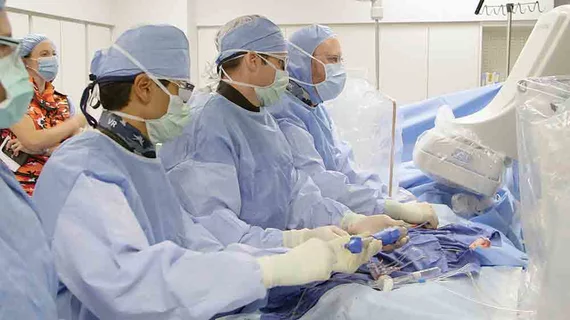High-risk TAVR, SAVR patients see similar survival at 5 years
High-risk transcatheter aortic valve replacement (TAVR) patients see the same rates of functional recovery and survival as surgical aortic valve replacement (SAVR) patients half a decade after their procedures, according to data published in the Journal of the American College of Cardiology.
The JACC installment expands on previous results from the CoreValve U.S. Pivotal High Risk Trial—the first randomized trial to suggest TAVR with a self-expanding supra-annular valve could be superior to SAVR for a primary endpoint of all-cause mortality at one and two years. Until now, researchers weren’t sure if TAVR would keep that edge at five years.
“Long-term durability has been a major concern for all biological replacement valves,” lead investigator Thomas G. Gleason, MD, and coauthors wrote. “This is the first randomized trial to our knowledge to report mid-term five-year hemodynamic outcomes with this self-expanding valve in high-risk patients compared with surgery.”
Gleason, chief of cardiac surgery at the University of Pittsburgh School of Medicine, and colleagues analyzed data from 750 aortic stenosis patients, 391 of whom underwent TAVR and 359 of whom underwent SAVR at 45 health centers in the U.S. On average, patients were 83 years old.
All TAVR patients were implanted with the CoreValve System manufactured by Medtronic, which funded the trial.
Five years after intervention, the authors reported all-cause mortality rates were 55.3 percent for TAVR and 55.4 percent for SAVR. Five-year rates of major stroke were 12.3 percent and 13.2 percent for the interventions, respectively, and freedom from severe structural valve deterioration (SVD) was 99.2 percent and 98.3 percent, respectively. Gleason et al. said they didn’t observe any significant valve thrombosis in the study population.
“These results are very encouraging because they corroborate the five-year outcomes of the PARTNER IA trial, underscoring the safety and efficacy of TAVR at mid-term follow-up,” the team said. “Early concerns that transcatheter aortic valves would not have the same mid-term durability as surgical bioprostheses has been tempered by these two pivotal trials.”
Still, they wrote, since surgical bioprostheses don’t typically experience significant SVD until eight years post-op, they haven’t gleaned enough data to compare valve deterioration between transcatheter and surgical bioprostheses over the long term.
Gleason and colleagues said freedom from valve reintervention at five years was high in both TAVR and SAVR patients, reaching 97 percent in the TAVR group and 98.9 percent in the SAVR group. Still, a permanent pacemaker was implanted in 33 percent of TAVR and 19.8 percent of SAVR patients.
The authors said their results support TAVR as a “reasonable alternative” to SAVR in high-risk populations and back its current Class I indication.
“In high-risk patients with aortic stenosis, TAVR with self-expanding bioprostheses are associated with survival, safety and functional outcomes at five years similar to those with SAVR, and SVD was infrequent with either method,” they wrote. “Long-term studies are needed to assess the structural valve deterioration and clinical outcomes to establish the appropriateness of TAVR for patients with greater life expectancies.”

